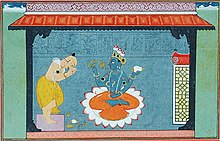Manipuri Vaishnavism
| Founder | |
|---|---|
| Rajarshi Bhagyachandra | |
| Regions with significant populations | |
| Manipur and other Northeast Indian states | |
| Religions | |
| Hinduism | |
| Scriptures | |
| Mahabharata, Bhagavad Gita, Bhagavata Purana | |
| Languages | |
| Meitei language |
| Part of a series on |
| Vaishnavism |
|---|
 |
Manipuri Vaishnavism, also known as Meitei Vaishnavism (Manipuri: ꯚꯩꯁꯅꯚ ꯂꯥꯏꯅꯤꯡ, romanized: Bheisnabh Lāinīng, lit. 'Vaishnaiva religion') is a regional variant of Gaudiya Vaishnavism with a culture-forming role in the north-eastern Indian state of Manipur.[1]
Manipuri Vaishnavas do not worship Krishna alone, but as Radha-Krishna.[2] With the spread of Vaishnavism, the worship of Krishna and Radha became the dominant form in the Manipur region. With every village there having a thakur-ghat and a temple.[3]
Background
[edit]Vaishnavism in Manipur has extended history. While there are records in the Puranas as to account of the pre-historic forms of Vaishnavism or Bhagavatism in the area of present state, the modern history of Vaishnava practices in Manipur started with a king of the Shan Kingdom of Pong gifting a murti of the Sudarshana Chakra (the celestial discus of Vishnu or Krishna) to Kyamaba, king of Manipur, so since the 1470s the kings of Manipur started worshiping Vishnu. Many Brahmana priests from the west, main areas of India, came to Manipur and settled there. The account of the arrival of Brahmanas is found in the records of the book Bamon Khunthock. King Kyamba (1467–1523) built a Vishnu temple in Vishnupur, a notable architectural monument. In 1704 King Charai Rongba was initiated into Vaishnava tradition and since then Vaishnavism became the state religion. This consolidated the cultural contact with India even further. After a short period of Vaishnavite Ramaism penetration, Gaudiya Vaishnavism spread in the early 18th century, especially from beginning its second quarter.[4] King Gharib Nawaz (Pamheiba) was ruling from 1709 to 1748 and he was initiated into Vaishnavism of Gaudiya Chaitanya tradition, by followers of Narottama Dasa Thakura. He practiced this religion for nearly twenty years. Preachers and pilgrims used to arrive in large numbers and cultural contact with Assam was maintained.[5] It is believed that the wave of devotion that turned the entire kingdom Krishna conscious took place during the reign of Gharib Nawaz’s grandson Bhagyachandra.
King Bhagyachandra
[edit]King Ching-Thang Khomba, also known as Rajarishi Bhagyachandra, was most devoted ruler and propagandist of Gaudiya Vaishnavism, under the influence of Narottama Dasa Thakura's disciples, and who has visited the holy for the Chaytanyaits Nabadwip.[citation needed] He ascended the throne in 1759; however, in 1762 the Burmese invaded Manipur, and the king, with his queen and a few attendants, fled to the neighboring state, now known as Assam. The dispute over real identity of the king, called for a demonstration of supernatural powers, believed to be attributed to the king. It is believed that Bhagyachandra had a revelation from Krishna in a dream; based on this revelation, he committed himself to making worship of Govinda the state religion on return to power in Manipur. It is believed that the murti of Govinda was to be made of the specific sacred tree and carefully planned rasa-lila dances to be instituted in the country, which was regained with the help of the king of present-day Assam. On reinstating the throne, a Govinda idol was installed and regularly worshiped; later a Radha idol was installed and worshiped next to it.[4][6]
Impact of Gaudiya Vaishnavism
[edit]
The Meiteis or Manipuris were initiated to the religion of Chaitanya during the middle of the 18th century. With a vast cultural changes during the then king Bhangyachandra, which include development of raslila dance drama of Manipuri Raas Leela dedicated to ras of Krishna and gopis, which is well known to the world, the image of Manipuri society changed and evolved as a sanskritised society. Various other literature of gaudiya sampradaya was translated and thoroughly studied. This also included chantings and sankirtana. Various other dance drama were also composed like gaura lila and six form of ras lila and performed in villages of Manipur. The manipuri rasa-lila dance is evolved from dances of lai haraoba performed by maiba and maibi, priests and priestesses of traditional meitei religious beliefs before Vaishnavism in Manipur. Rasa-lila and Manipuri Sankirtana or Nata Sankirtana which is also a UNESCO Intangible Cultural Heritage of Humanity, became the important features of day to day life. In all rituals non-vegetarian foods is completely prohibited.
Even though Krishnaism became a prominent part of Meitei religious beliefs, they never stopped worshipping the traditional deities. The older deities with similar concepts were equated with different other Hindu gods, like Nongpok Ningthou and Panthoibi with Shiva-Parvati. There are many temples in Imphal valley like Hiyangthang Lairembi Temple where the deity is worshipped in both Sanamahism and Vaishnavism way.
See also
[edit]Notes
[edit]References
[edit]- ^ Singh 2004, pp. 125–132.
- ^ Encyclopaedia of Indian Literature - p. 4290, Amaresh Datta, Mohan Lal (eds.), 1994.
- ^ Shanti Swarup (1968). 5000 Years of Arts and Crafts in India and Pakistan. New Delhi. p. 272.
{{cite book}}: CS1 maint: location missing publisher (link)p.183 - ^ a b Singh 2004, p. 128.
- ^ Medieval Indian Literature: An Anthology. New Delhi: Sahitya Akademi. 1997. ISBN 81-260-0365-0.p.327
- ^ "Krishna Conscious State". Archived from the original on 16 May 2008. Retrieved 17 May 2008.
Bibliography
[edit]- Singh, Kunj Bihari (2004) [1963]. "Manipur Vaishnavism: A Sociological Interpretation". In Rowena Robinson (ed.). Sociology of Religion in India. Themes in Indian Sociology, 3. New Delhi: Sage Publ. India. pp. 125–132. ISBN 0-7619-9781-4.
External links
[edit]- "Manipur: A Land of Krishna Conscious Culture". Jayadvaita Swami. Archived from the original on 16 May 2008. Retrieved 17 May 2008.
- "How Manipur Became a Krishna Conscious State". Jayadvaita Swami. Archived from the original on 16 May 2008. Retrieved 17 May 2008.
